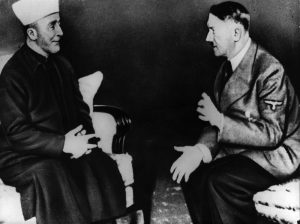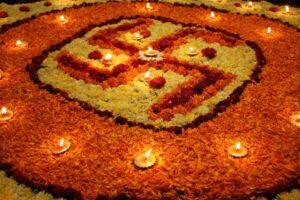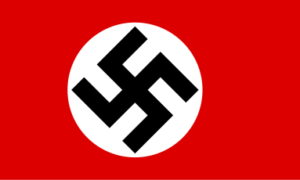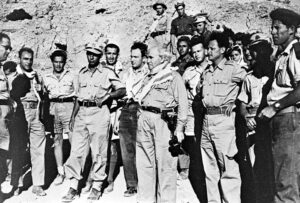“What is there to separate the Muslims in Europe and around the world from us Germans? We have common aims. There is no more solid basis for cooperation than common aims and common ideals. For 200 years, Germany has not had the slightest conflict with Islam.” Himmler
Hard to believe that two of the most benign, ancient symbols of love have been culturally appropriated and turned into symbols of hate – toward the Jews: the Nazis with the Swastika and the “Palestinians” with the Kaffiyeh. Two barbaric civilizations took two symbols of peace and turned them into Jew-hating emblems. Both “civilizations” want the final Solution-the death of all Jews.
Don’t be so surprised. The bond between the Nazis and Muslims runs deep in their history and symbolism.

Adolf Hitler talking to Grand Mufti Haj Amin el Husseini. (Photo by Keystone/Getty Images)
Many know some of the history of the Swastika and the Nazis, but let’s review.
The Swastika comes from Mesopotamia ( between 5500 and 4800 BCE) and can be mapped from the Halaf culture in Upper Mesopotamia, through Mesopotamia during the Hassuna and Samarra cultures, and down to the Ubaid culture by the Persian Gulf. Later, the Ubaid culture is replaced by that of the Uruk period.
Time passed and the swastika, commonly assumed to be an Indian sign, came to be a sacred symbol used by Hindus, Buddhists and Jains for millennia.The word swastika comes from the Sanskrit svastika, which means “good fortune” or “well-being.”. It indicates, among other things, good luck, the infinity of creation and the unconquered, revolving sun.
In Scandinavia the left-hand swastika was the sign for the god Thor’s hammer. The swastika also appeared in early Christian and Byzantine art where it became known as the gammadion cross, or crux gammata, and it appeared in South and Central America (among the Maya) and in North America (principally among the Navajo). In India the swastika continues to be the most widely used auspicious symbol of Hindus, Jainas, and Buddhists. A clear distinction is made between the right-hand swastika, which moves in a clockwise direction, and the left-hand swastika (more correctly called the sauvastika), which moves in a counterclockwise direction. The right-hand swastika is considered a solar symbol and imitates in the rotation of its arms the course taken daily by the Sun, which in the Northern Hemisphere appears to pass from east, then south, to west. The left-hand swastika more often stands for night, the terrifying goddess Kālī, and magical practices.
In the beginning of the twentieth century the swastika was widely used in Europe. Early Western travelers to Asia were inspired by its positive and ancient associations, a symbol of good luck and auspiciousness and started using it back home. By the beginning of the 20th Century there was a huge fad for the swastika as a benign good luck symbol.

After World War I,the swastika an ancient symbol, was hijacked, culturally appropriated by the Germans and perverted and twisted into the graphic embodiment of intolerance. Adolf Hitler adopted the swastika as the primary symbol for the Nazi Party in 1920. On September 15,1935, the black swastika on a white circle with a red background became the national flag of Germany. Various right-wing adherents of the so-called “völkisch” movement in Germany, a movement in large part dedicated to uncovering a romanticized and largely mythical German/ “Aryan” past, adopted the swastika as a symbol.
.
The icon was chosen by the party to represent its goal of racial purification in Europe. Hitler and his Nazi Party believed that a line of pure Germanic ancestry originating in the Aryan race—a grouping used to describe Indo-European, Germanic, and Nordic peoples—was superior and that other, less-superior races should be ousted from Europe. Ancient Indian artifacts once owned by Aryan nomads were found to frequently feature the swastika, and the symbol was co-opted from its ambiguous historical context in the region to exert the dominance of so-called Aryan heritage.
The murderous legacy of the Nazi regime, especially the Holocaust, permanently converted the swastika into a symbol of hate, anti-Semitism and infamy.
From love to hate.
Fun Fact – the Kaffiyeh is not a creation of the Palestinian people – its true history predates the idea of Palestine-Arab or Muslim by thousands of years. Seems the kaffiyeh, like the swastika, originated in Mesopotamia. Dating back to Sumerian priests of Mesopotamia in 3100 BCE, a version of the keffiyeh was worn to distinguish honour and rank in society. The actual word ‘keffiyeh’ has its origins in the ‘Kufa’ area of Iraq and means “from the city of Kufa”. Over the years it spread across the Middle East with each country proudly wearing a pattern and style distinct to their region.
During the reign of the Ottoman Empire, the fez, or tarboosh, was more commonly worn by the urban educated elite, the effendi, while the keffiyeh was associated with rural farmers and peasants, the fellahin, who used it to shield themselves from the sun, dust, and sand.
Traditionally crafted from cotton, it was first donned by the nomadic Bedouin tribes as a protection against the desert sun and sand.
The keffiyeh’s usefulness in the desert landscape played a key role in its widespread popularity across diverse cultures in the region. At the turn of the 20th century, both Jewish and Arab communities wore the keffiyeh.
The patterns on the kaffiyeh have meaning. The net like pattern represents fishing nets in rivers marshes and swamps – places that Mandeans, the original inhabitants of Mesopotamia.-the indigenous people-called home; now modern day Iraq.
The smaller rippled lines mimic the flow of water movement in rivers and swamps.
The two wide black stripes represent two rivers – the Tigris and Euphrates; the life blood of Mesopotamian civilization and people
Arab forces invaded Mesopotamia in the 7th century and brought military occupation and forces to the area. The ancient culture was erased and or appropriated and the land was colonized by the Arabs.
Many Jews who moved to Ottoman- and British-controlled area of land called Palestine(from the early 1300s until 1922) chose to wear the keffiyeh because they saw it as part of the authentic local lifestyle.

Israeli Prime Minister David Ben-Gurion wearing a keffiyeh on a tour of the Negev region in 1949. National Photo Collection of Israel, Photography dept. Government Press Office
Today, the “Palestinians” who culturally appropriated the kaffiyeh, have given it their own history and meaning – like the Nazis and the swastika.
Some of the appropriators say patterns on the keffiyeh symbolize different aspects of Palestinian life: the bold black stripes on the edges symbolize the historical trade routes that used to go through Palestine; the fishnet-like design represents the Palestinians’ ties to the Mediterranean Sea; and the curvy lines resemble olive trees, a major point of pride for Palestinians. (Keep in mind – Palestine is an area of land – not a people or nation state – that was called Israel until the Romans changed the name to Palestine following the exile of the Jews in the early first century CE).
It’s really not until the 1930s that the keffiyeh took on a change in meaning, not by the patterning that’s in the scarf, but in its use. Until the 1920s, the keffiyeh was almost exclusively worn by Bedouin men, and it was simply a way to identify nomadic men in historic Palestine from villagers, fellaheen, and town people.
The keffiyeh was used as a political statement during the Arab Revolt in Palestine in 1936 — an uprising against British rule that included demands for independence and an end to Jewish immigration. The revolution’s leaders issued an order for men to wear the keffiyeh to express solidarity with the revolutionaries, often covering their faces with it to conceal their identities from British authorities and to prevent the British from distinguishing the fighters from others. Nothing has changed. Those who wear the keffiyeh in antisemitic protests continue to hide their faces.
In the 1960s, it became associated with “Palestinian nationalism,” particularly due to its adoption by leaders like Yasser Arafat. It was Yasser Arafat who culturally appropriated the shemach/ keffiyeh, in the 1960’s, and made it a symbol of Palestinian terrorism against the Jews and other minorities in the area. He typically draped his headdress in the shape of Israel, the West Bank and Gaza Strip.
People now wear the kaffiyeh, often referred to as Palestine’s unofficial flag, as a symbol of Palestinian resistance. The kind of “resistance” that includes rape and the burning of Jews alive in their own homes.
And the two have now become as one. A picture is worth a thousand words. Nothing like a Nazi salute whilst wearing a keffiyeh.

All that is missing from the photo is the swastika. I am sure it’s out there. Feel free to share.
.
From the Ethics of the Fathers: “Rabbi Tarfon used to say, it is not incumbent upon you to complete the task, but you are not exempt from undertaking it.”
Diane Weber Bederman




